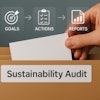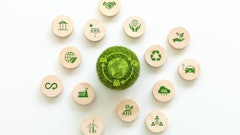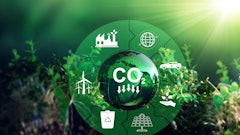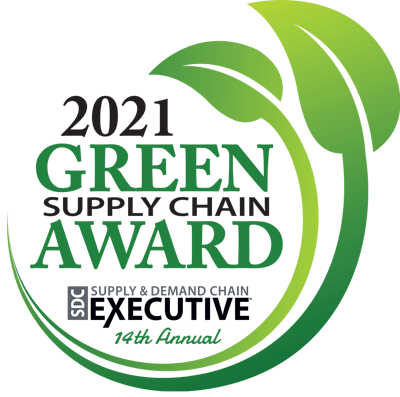
The idea of a sustainable or a “green” supply chain is much different than its definition even just a few years ago. Today, many refer to the significant disruptions in the supply chain as “The Supply Chain Crisis” and its vast reaching issues push consumers and companies alike to rethink their values. The conversation circling the supply chain industry right now centers mostly on reform and resiliency, where sustainability makes an impact.
Supply and Demand Chain Executive’s 2021 Green Supply Chain award celebrates those in the industry that not only kept up green initiatives throughout a global pandemic and unprecedented disruptions, but also made them a priority. In addition to shutdowns, backlogs and the worker shortage, natural disasters created additional havoc for the supply chain in the last year, an element that can be combatted through green initiatives like those that our winners created.
While every consumer, organization and company play a role in the environment, the supply chain is one of the most influential industries regarding sustainability. Thankfully, members in the supply chain know this and develop new, modern strategies to better provide a sustainable future. Issues such as labor welfare, waste reduction and renewable energy became an important part of executives’ values throughout the past year. According to a study from CSCMP and MIT, 59% of supply chain companies invested in sustainability throughout 2020. The companies cited employee welfare & safety, human rights protection and energy savings/renewable energy as the top three concerns in regard to sustainability.
This year’s batch of winners exhibited great concern for issues like these and a commitment to creating a better supply chain. Hopefully, many others in the supply chain will follow suit and we will see a bright and strong industry in the near future. We thank these companies for the hard work they put into these projects and are excited to see what more they bring to the table.
Please join Supply & Demand Chain Executive in congratulating the Green Supply Chain award winners.
CLICK HERE to view all winners.
Here are some select standouts:

ALOM
alom.com
In March, ALOM publicly announced its NetZero Supply Chain Sustainability Initiative, designed to achieve a net zero carbon footprint by the year 2030 across all internal operations and client supply chain service programs. The NetZero Supply Chain Sustainability Initiative puts in place a structure (and stakeholder accountability) to implement, report and track carbon footprint reduction progress. The Net Zero Supply Chain Sustainability Initiative will focus on Scope 1 and Scope 2 greenhouse gas (GHG) reduction in the atmosphere to mitigate human impacts accelerating global climate change. Specifically, ALOM will drive three key programs that will be tracked, measured and reported through the company’s ISO 14064-1 certification/documentation requirements. Currently, the ALOM NetZero Supply Chain Sustainability Initiative has 47 individually monitored and reported programs in place comprising the use of renewable energy, optimizing freight, supply base restructuring and near-sourcing, adopting energy-saving technology, sourcing and procurement of enviro-friendly materials, packaging and operational efficiency. For example, ALOM incorporates highly efficient LED, motion sensor lighting in its warehouse and production areas. It only uses rechargeable electric-powered lift equipment. It focuses on reducing waste and increasing the volume of recycled or recyclable materials used in operations. ALOM is also in the final stage of ISO 14064-1 certification which specifically monitors GHG Scope1 and Scope 2 emissions. In August, ALOM signed a deal with AES Indiana for the purchase of 100% of its domestic U.S. electricity generation from renewable sources. ALOM is currently 85% powered by renewable energy at its Fremont, Calif., headquarters, which will be 100% renewable powered by January 2022, pending the addition of new solar suppliers to its utility providers’ renewable power grid capacity.
“Our hope and ultimate goal is that other organizations will see the success and impact we are having, and over time, the ALOM NetZero Supply Chain Sustainability Initiative will serve as a blueprint for other organizations to follow suit in adopting and implementing similar highly impactful sustainability improvement program measures,” says ALOM. “For the NetZero Initiative to be meaningful, and not just another carbon footprint reduction goal announced to achieve a quick media eyebrow lift, ALOM understood the need for transparency in our reporting.”
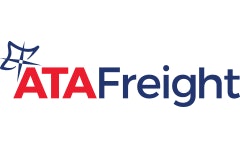
ATA Freight
atafreight.com
ATA Freight is a leading global logistics and freight forwarding services provider committed to protecting the Earth by reducing human impact on natural resources and participating in initiatives to reduce the global supply chain’s CO2 emissions. Since its inception 25 years ago, the company has been developing and deploying advanced technologies that optimize supply chain processes and provide complete visibility, which in turn, empowers more efficient supply chain operations. For example, ATA Freight developed a web-based shipment management solution that delivers real-time PO level tracking, order planning and shipment scheduling to streamline a shipment’s processing, transport/delivery times and its associated carbon footprint. The advanced 360-degree end-to-end digital global supply chain platform has a built-in feature that helps shippers gain greater insight into their shipments’ CO2 emissions. ATA Freight also adheres to advocates for the Global Logistics Emissions Council’s (GLEC) Framework and the Global Green Freight Action, and uses Green Counter’s advanced algorithms and smart prescriptive analytics to measure the carbon footprint of shippers utilizing its digital global supply chain platform.
“ATA Freight is focused on bringing shippers, forwarders and transportation companies to digital supply chain platforms to facilitate a more sustainable supply chain by driving optimized processes across all supply chain operations, which will help improve resource (e.g., transportation vehicles) management, and facilitate better, shorter shipment routing to help reduce carbon emissions,” says ATA Freight. “We are also continuing our R&D processes to develop new technologies, container options and other products that support sustainability by promoting less waste, recycling and/or upcycling of materials used on the supply chain, reduced energy consumption and lower CO2 emissions.”

Basware
basware.com
Basware helps enterprises decrease their carbon footprint by providing a variety of sustainable solutions like e-invoicing, procure-to-pay (P2P) automation and holistic digitization of organizations’ processes. As part of the Basware Analytics KPI overview dashboard, Basware includes a carbon footprint index calculated by the environmental impact of different invoice receiving methods. Companies can follow the development of their own CO2 index over time, as well as benchmark against the average carbon footprint within the Basware community. The dashboard also estimates how many trees or how much water a company has saved or will be able to save when onboarding more suppliers to e-invoicing. Companies can also view improvement potential per month. In short, by removing paper from finance and procurement processes, Basware lessens greenhouse gas emissions that paper produces when it’s sent off to a landfill or incinerated. Basware has thus far decreased emissions by 70%, beyond its emission target for 2016-2020 to decrease office-based CO2 emissions per employee by 20%. Also, in 2020, Basware moved offices in Amsterdam, Oslo and Munich into smaller spaces, therefore reducing electricity consumption from 396.8 MWh in 2019 to 78.1 MWh in 2020 and CO2 emissions from 91.5 in 2019 to 28.4 CO2 tons in 2020. Plus, Basware will be introducing climate-related incentives for the management of climate-related issues in the next two years.
“Basware encourages a paperless way of working, aligned with its solutions’ value proposition, and therefore, limits the environmental impact of their offices,” Basware says. “For example, the office park where the North American headquarters is located doesn’t offer a recycling program, so the Basware team was throwing countless aluminum cans into the trash until the head of marketing decided to place a receptacle in her office, take the cans home and recycle them through her residential program. Also, Basware names ‘green ambassadors’ in its offices that are spread across 14 countries. These individuals strive to move that needle forward, and given the varying needs in different geographies, can tailor programs and initiatives to suit their specific office (like the previous example).

Cass Information Systems, Inc.
cassinfo.com
Cass Information Systems, Inc. provides solutions designed to help customers meet green supply chain goals. This includes accelerating the amount of electronic interchange between Cass, its customer and their freight carriers, significantly reducing paper transactions in the areas of shipping documents, billing (freight invoices), payment transactions and information delivery through maximizing Electronic Data Interchange (EDI). In fact, Cass' annual EDI freight invoice percentage averages over 75%, with some clients’ average percentage as high as 98%. Utilizing Cass’ consolidated data center for business intelligence frees up the customer’s data center to provide further environmental impact. The Cass data center also continues to reduce energy consumption through the increased use of server virtualization, while Cass’ utilizes optimized energy performance offices and systems to further reduce energy consumption and expenses.
“Business intelligence also provides critical information for shipment optimization such as consolidating shipments, reducing unnecessary expedited shipments, route optimization or planning for optimum warehouse and distribution locations. These create opportunities for more efficient shipping and meeting green initiatives,” says Cass Information Systems, Inc.

Controlant
controlant.com
Controlant’s unique solution can measure multiple data points based on the customer’s pre-defined needs to improve corporate sustainability efforts. Using Controlant’s own analytics dashboards, businesses and their partners can reduce CO2 emissions by minimizing the number of returned, wasted or replenished products. Controlant’s solution can also help manufacturers and their external partners decide optimal routes that consume the least amount of fuel and have the fewest temperature excursions. This information reduces shipment rejections using Controlant’s proactive monitoring and visibility program. And, Controlant’s Cold Chain as a Service with logger pool management eliminates a considerable amount of plastic e-waste from going into landfills. In fact, one global manufacturer went from 150,000 single-use loggers to 30,000 multi-use loggers within one year. If placed one on top of each other, that amount of plastic waste would measure as high as Mt. Everest. By switching to a multi-use logger, this customer kept all that e-waste out of landfills. Controlant’s multi-use logger management services automate customers’ supply chain logistics efforts by replenishing reusable data loggers’ supply at the relevant production sites, warehouses and distribution centers. Within a vaccine distribution project, Controlant delivered over 1 billion doses with a 99.997% success rate. This means that it was able to safely protect the shipments from temperature abuse.

JAGGAER
jaggaer.com
JAGGAER's contract management solution is instrumental in helping clients improve sustainability by reducing the need for paper contracts and enabling customers to complete all contracts digitally. This contract management solution helps customers map their carbon footprint by identifying improvements that could be made. Additionally, JAGGAER offers an entire database that allows users to compare and identify sustainable suppliers in their market. JAGGAER also provides raw data reflective of the individual decisions each of its customers make that directly impact their ESG score. These quantifiable statistics are delivered on a large scale all the way down to a specific invoice.
“JAGGAER places high priority on becoming the single most sustainable software business worldwide in addition to maintaining a sustainable supplier base for its users. Moreover, JAGGAER aspires to not only maintain a focus on sustainability, but also the entire environmental, social and corporate governance structure,” JAGGAER says. “JAGGAER has two parts of business. The first of these is empowering customers in being sustainable. JAGGAER continues to aim for improving its sustainability in the procurement space by selecting suppliers that also promote sustainability. The second of these is becoming the No. 1 provider in ESG solutions.”

Mazree
mazree.com
Mazree enhances sustainability in the healthcare supply chain by redeploying, reselling and recycling used medical equipment. Mazree’s proprietary software consists of a redeployment portal with automated auctions that enable clients to maximize the use and value of their assets. If Mazree is unable to redeploy or resell the used medical equipment, then it coordinates with an ISO 14001-certified local recycler to responsibly recycle the equipment.
“We track and monitor the status of every piece of medical equipment within our software. We model this data into business intelligence reports accessible to all clients. In the last two years, we have redeployed 233 assets, resold 8,670 assets and recycled more than 60,000 pounds of medical equipment,” says Mazree. “Our primary goal is to have zero pieces of medical equipment end up in a landfill. We are hoping to enhance our sustainability impact by partnering with more than 20 health systems in the next five years to help them properly manage their used medical equipment. These efforts will result in higher cost avoidance for each health system, more equipment recycled, and less equipment ending up in landfills.”
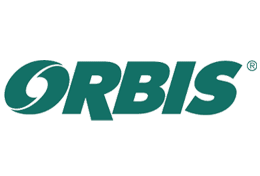
ORBIS Corporation
orbiscorporation.com
ORBIS Corporation converts single-use wood or corrugated packaging to reusable packaging for automotive, industrial, retail and more. ORBIS’ portfolio of totes, pallets, carts, mobile pallets, racks and bulk systems are designed to improve product flow, reduce costs, enhance safety and increase sustainability. In fact, 97% of ORBIS products are readily recyclable into new packaging products at the end of their service life. ORBIS also created Ocean in Mind, an initiative that recovers plastic waste from coastlines and repurposes it back into reusable packaging solutions. This year alone, ORBIS is diverting roughly 1 million pounds of single-use plastic waste from oceans and waterways -- equivalent to 50 million shampoo bottles. What’s more is, ORBIS helps customers measure and reduce their overall environmental impact using life-cycle assessments. This Environmental Audit service compares single-use packaging with reusable packaging in terms of cost per trip, savings over packaging life, solid waste, energy and greenhouse gas emission. ORBIS uses this tool to fully understand the impact a reusable plastic packaging program can have on a customer’s supply chain. The assessment reviews marketplace trends, supply chain complexities, regulatory issues, supplier relationships, customer requirements, labor practices, transportation standards, cleanliness requirements, import/export requirements and product life cycles.
“ORBIS tracks and measures its own resource utilization to continuously conserve natural resources and reduce waste. For example, 99% of water used in its manufacturing process is re-used. Reusable plastic packaging is inherently sustainable given that it is used over and over during its service life, putting sustainability at the core of ORBIS’ business,” ORBIS says. “ORBIS, along with its parent company Menasha Corporation, publishes an Annual Corporate Social Responsibility Report, which summarizes its environmental performance and other social responsibility initiatives. Specific results entail reducing greenhouse gas emissions by 18%; reducing water usage by 96%; reducing solid waste by 14%; and reducing electrical usage by 21%.”

Ryder System, Inc.
ryder.com
Ryder is uniquely positioned to reduce the environmental impacts of its own operations and its customers’ operations. By utilizing Ryder’s supply chain and dedicated transportation solutions, customers benefit from maximizing freight tonnage delivered per shipment and per mile and minimizing fleet emissions and related fuel costs. From reducing waste at 1,200 locations, deploying alternative fuel vehicles (AFV) and electric vehicles (EV) and optimizing logistics networks, Ryder has reduced CO2e emissions over 21% since 2009. To improve fuel economy and reduce greenhouse gas (GHG) emissions, Ryder also invested in state-of-the-art vehicles, fleet management solutions and diagnostic technologies that expand cleaner-burning fuel capabilities; maximize vehicle performance; improve cargo dispatching, loading and routing efficiencies; drive fuel savings; and improve driver skill. For example, Ryder reduces emissions significantly through the RydeSmart program, designed to deliver up to 10-15% reduction in fuel consumption through improved routing, driving habits and reduction of unauthorized use and idle time. Ryder has invested $100 million in alternative fuel solutions and helped over 70 customers convert to newer fuel technologies. Ryder also collaborates with OEM partners to incorporate more EVs into their fleet. Ryder has also prioritized four types of innovative technologies most applicable to creating and supporting a smart warehouse--robotics, sensors and automatic identification tools, wearables and drones. Ryder Smart Warehousing yields a 33% increase in efficiency, 20% operational cost savings and other operational benefits.
“Ryder engages employees to drive continued conservation initiatives that will reduce facility energy use through lighting management and improved equipment maintenance procedures. Field employees can access our energy reporting tool, which tracks Scope 1 and 2 emissions and provides visibility of local operations. Management receives internal reports on GHG trends and energy usage updates, and the information is distributed to field employees to support transparency. Business unit directors are incentivized to attain targets for energy use reductions and associated GHG emissions reductions from conservation programs, awareness campaigns and other activities,” says Ryder. “After meeting our 2020 goal early to reduce Scope 1 and Scope 2 emissions 20% over a 2009 baseline, we recently implemented new enterprise-wide targets to drive our strategy over the next three years while finalizing our long-term targets. To develop our new emissions targets, we closely tracked and evaluated material factors that influence emissions across the value chain. We identified priorities that present the greatest opportunity to reduce emissions and close existing data gaps while evaluating the resources available (and needed) to achieve these goals, which include reduce Scope 1 emissions (company-operated fleet) 10% by 2024, over 2018 baseline; reduce Scope 2 emissions (company-operated facilities) 30% by 2024, over 2018 baseline; and reduce Scope 3 emissions (upstream/downstream sources, including leased equipment) 15% by 2024, over 2018 baseline.”
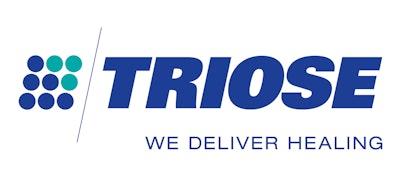
TRIOSE, Inc.
triose.com
TRIOSE believes that the collective future depends on environmental sustainability, and that’s why it is a key factor in planning and evaluating strategic initiatives and day-to-day operations. One of the ways TRIOSE works to reduce impact is by seeking out and prioritizing partnerships with other organizations. In 2018, TRIOSE launched a partnership that grants healthcare providers nationwide with access to Green Cell Foam, a biodegradable, sustainable packaging solution made from food-grade cornstarch that dissolves in water. The foam protects the most at-risk shipments from costly damages and claims while protecting the environment from harmful waste. TRIOSE also designed its courier and fleet solutions to enable healthcare clients to operate efficiently through route optimization and vehicle maintenance programs that reduce fuel consumption and overall carbon footprint. TRIOSE measures reduction in CO2 per shipment, use of low-carbon and electric vehicles, reduction in packing materials waste and optimized deliveries to benefit clients’ timelines and energy consumption reduction.
“Whether it’s for the community, environment, clients, partners or each other, TRIOSE is deeply committed to social responsibility and doing the right thing. We developed a program called Give Five, which encompasses five pillars that represent how we are making a positive impact on the world around us. The pillars include charity, volunteerism, veteran support, environmental sustainability and ethical conduct. Everything we do at TRIOSE ladders up to the Give Five program and pillars,” says TRIOSE. “As we look to the future, TRIOSE’s primary focus is two-fold -- continue to develop innovative solutions that both minimize environmental impact and benefit our healthcare clients and their patients and implement environmental sustainability initiatives that are forward-thinking and drive change in the industry. We believe it’s crucial to seek out other carrier partners who share our strategic environmental goals and engage with other innovative organizations in the transportation and healthcare sectors. Additionally, we are committed to using more alternative fuels in vehicles and reducing our environmental footprint as much as possible.”
CLICK HERE to view all winners.



